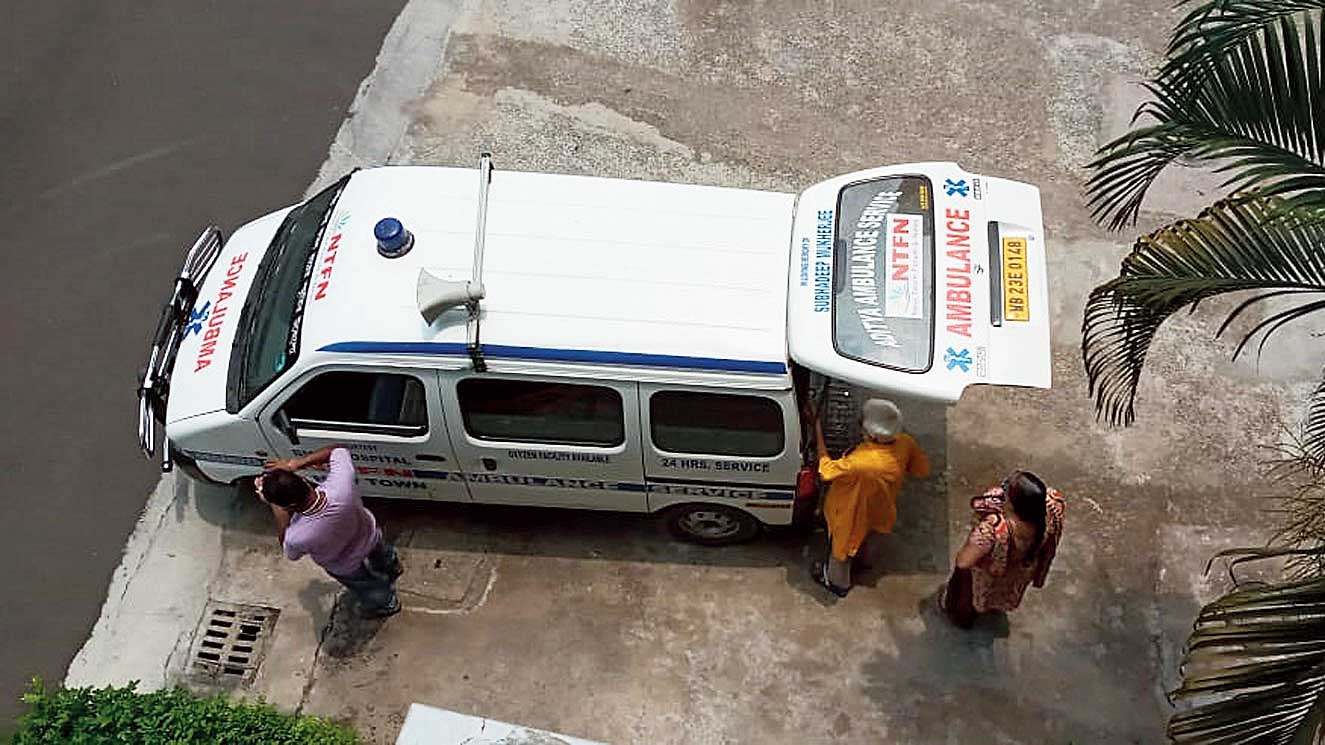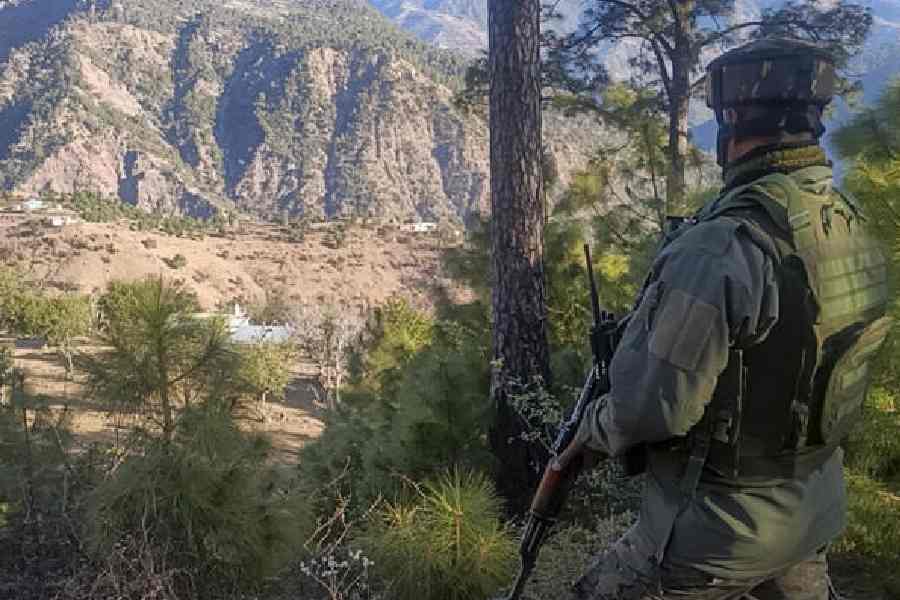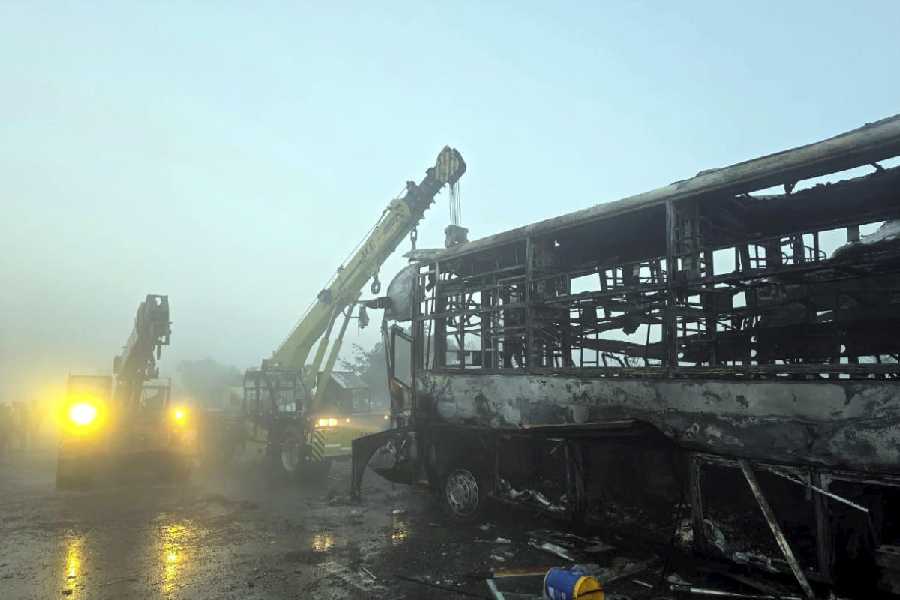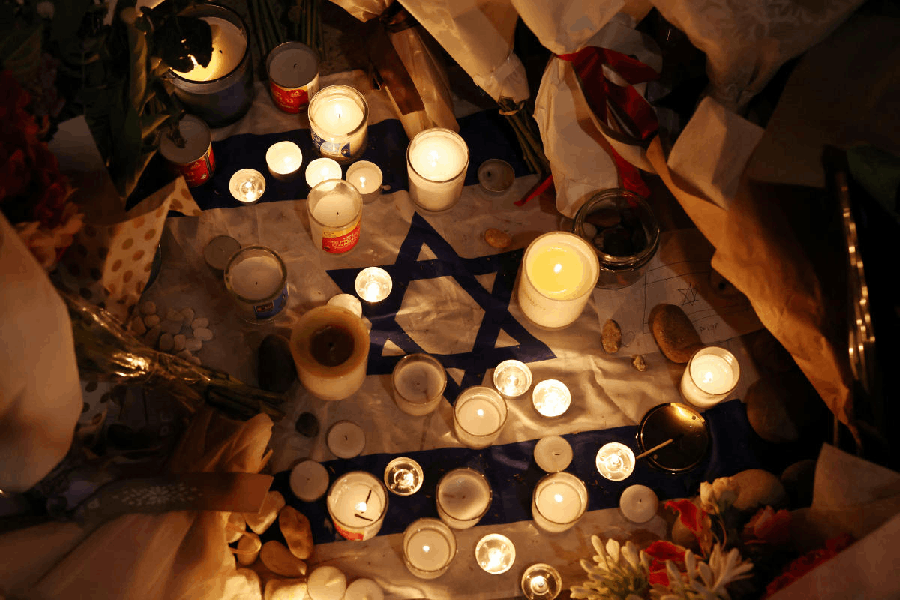There’s nothing more precious now than a hospital bed but let us not forget the contribution of those ferrying patients from hospital to hospital, in search of that elusive bed.
These men are driving for hours at a stretch without food or water, as they cannot remove their PPEs. They sweat profusely but have no time or place to bathe. Hounded by phone calls round the clock, they don’t remember the last time they slept an entire night. They don’t have time to queue up for vaccines so many are living in fear of contracting or passing on Covid to their families.
Patient parties are crying foul over ambulances charging nearly Rs 10,000 for rides even within Salt Lake but ambulance owners say they are victims of the system too.
Beasts of burden
The volume of work has increased to inhumane levels, say ambulance operators. “There have been times when we worked 10 days at a stretch without going home,” says Laltu Das Mondal, who drives a Columbia Asia ambulance. “We were burning out and have stopped that now.”
Mangal Das used to only manage Loknath Ambulance Service but such is the rush now that the senior citizen is having to sit behind the wheel and drive around patients too. “We had initially reserved four of our 10 vans for Covid duty but Covid patients just keep increasing. We are having to send them non-Covid vans too,” says the Kestopur resident who has moved into a room on his terrace to keep distance from his family.
There’s no telling when, or if at all, drivers go home in a day now. They are eating biscuits, bathing at pay-and-use toilets and sleeping 40 winks in the ambulance in between duty. “Our gari has become our bari,” Mangal sighs.
Soumen Mahesh of Kankurgachi’s Usha Ambulance Service has not slept in 25 nights and cannot recall the last meal he ate. By the time Biswajit Mahesh of Biswajit Ambulance Service reaches home, he can do no more than drop dead. “Even then I can’t sleep as calls keep coming and I have to rush out again. We feel sick wearing PPEs the whole day, our neighbours ostracise us saying we shall spread Covid in the neighbourhood. We are going through hell,” he says.
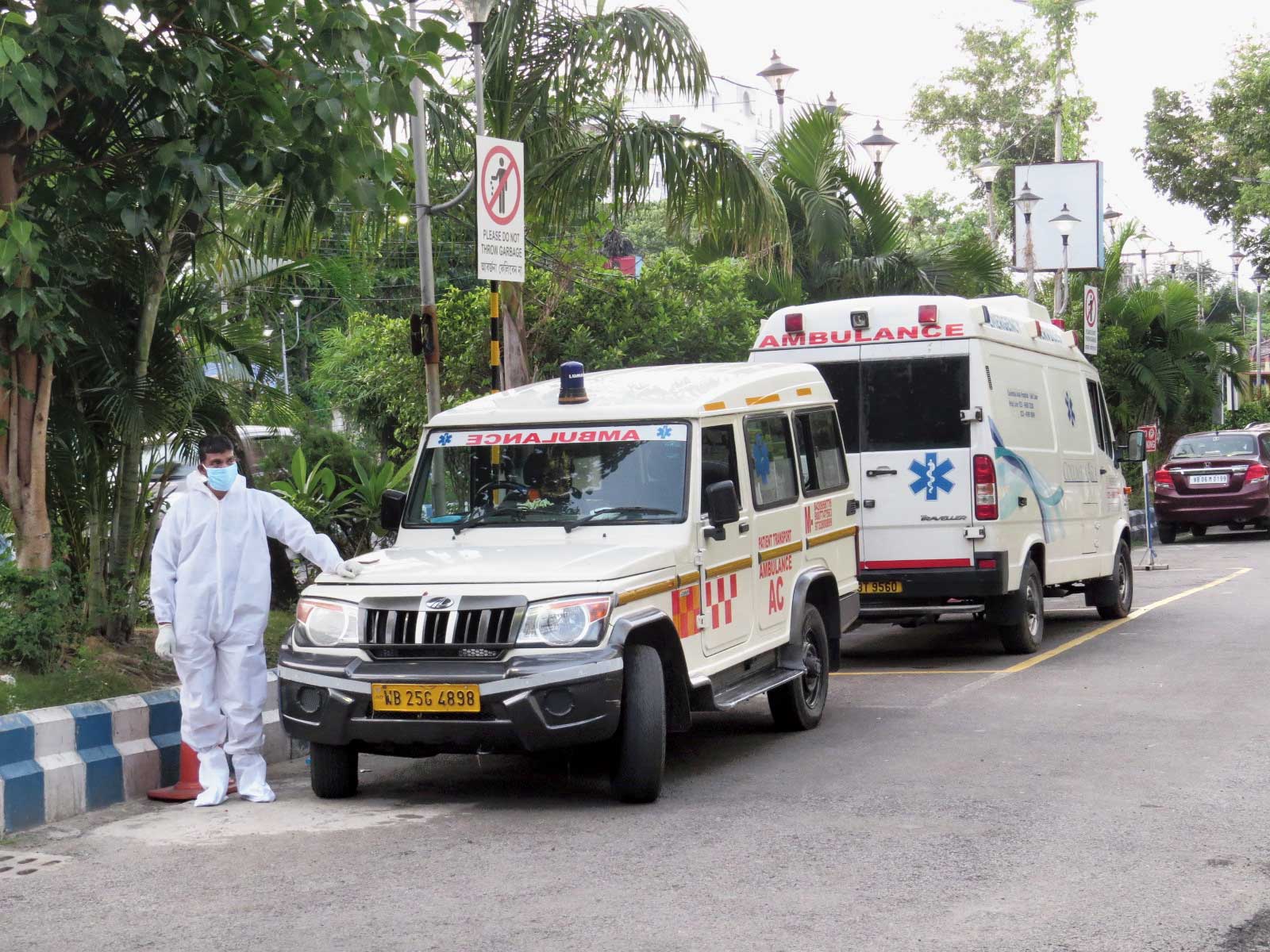
An ambulance driver awaits his next trip in front of a Salt Lake hospital. Picture by Sudeshna Banerjee
No to Covid patients
Some of Soumen’s drivers have flatly refused to ferry Covid patients so he has had to keep some ambulances reserved for non-Covid patients. “Plus the drivers are asking for more money to work in a pandemic situation,” he says.
Two of Biplab’s drivers have quit in fear, “and the mothers of two more are calling me from their village every day, pleading with me to let their sons go. I am lying to them. I am telling them their sons are not on Covid duty,” says the man behind Krishna Social Service, helplessly.
Tapan Pal used to be a taxi driver but made the switch to driving an ambulance a year ago. “Lockdown ey khabo ki?” he counters on being asked why. "My own car had to be scrapped as it was over 15 years old and I was driving someone else's cab when the pandemic began,” he says, standing next to his ambulance at Columbia Asia Hospital.
But he refuses to pick up Covid patients and would not take up a better-paying job with a Covid hospital. “I have a family to get back to,” the 51-year-old from Kadapara reasons.
The FD Block Association ambulance is not catering to Covid patients. “Before you label us as selfish, think of dialysis patients. With their weak immunity, can they risk boarding a van frequented by Covid patients? Many such patients are asking specifically for non-Covid ambulances,” says Ashis Saha, who manages their two ambulances and a hearse. They are all non-Covid.
There have been occasions when halfway through a trip the patient shows Covid symptoms. “On humanitarian grounds we have dropped them to their hospitals and sanitised our van rigorously,” says Saha. “But the other day we got a call from an AA Block resident asking us to pick up a relative from a Barasat hospital. They assured us she wasn’t a Covid patient but we saw her coming out of Covid ward. They had lied to us. We left without the patient.”
Same with Radha Krishna Ambulance Service. “I am not taking Covid patients. Period,” says the owner, without sharing his name. “I check symptoms before allowing in a patient and if the case is suspicious, I leave without a word. I know I can mint money if I take Covid patients now but I have a family at home. I’m happy being a small fish.”
Patients hiding symptoms
Fearing refusal, patient parties sometimes hide Covid symptoms from ambulance drivers. This doesn’t play out well as the drivers and helpers may not be wearing PPEs that day and end up with Covid themselves.
“We got duped many a time,” says Tapan Giri of Bidhannagar North Society For Social Welfare. “Our ambulance is run by an NGO with limited funds. We could never afford multiple PPEs so we never catered to Covid patients to begin with. But patients would hide their symptoms till our driver and helper both got sick. They were scared for their lives and refused to work thereafter.”
So since December their ambulance is gathering dust near Bidhannagar north police station. “We still get calls but there is no driver!” says Giri.
Ride only if bed confirmed
Such is the rush that some ambulances are now accepting patients only if they have beds confirmed at a hospital. “Otherwise we end up visiting five or six hospitals, only to be turned away from them all. Patients are dying in vans and I cannot have that. If my ambulance has oxygen to last five hours I tell the patient I have oxygen for two hours, keeping some time in hand. By that time, I tell them they must let the van go,” says Susanta Kumar Ghosh of Susanta Ambulance.
Some like Biswajit’s agency are tied up to certain hospitals and nursing homes. “So we are mostly asked by hospitals to go pick up patients and there isn’t a problem of beds,” he says.
No beds in sight
Mangal says he doesn’t have the heart to ask callers if they have beds confirmed because he knows they do not. So he has devised a system of “shuttling”. On an average, patients are visiting five or six hospitals a day, where the private institutions are taking two hours to check and refuse the patient and the government ones are taking even longer. But even while waiting, the driver’s phone never stops ringing as other patients need his services.
“So we are now dropping off patient A on a wheelchair or stretcher at a hospital and going to pick to patient B. By the time we drop B to another hospital’s wheelchair, patient A has been refused and we return to pick him and drop him at another nursing home,” says Mangal. “There’s no other way the existing fleet of ambulances in the city can serve so many patients at once.”
Dipak Pandit explains how the same patient has been hiring his ambulance for two days in a row now. “This man used to be a top ranking government official back in the day but now all his contacts and connections cannot get him a bed. Our ambulance is taking him to the biggest of hospitals and smallest of nursing homes, only to drop him home at the end of the day,” says Dipak. “He will probably hire the van again tomorrow.”
Soumen says many patients are not even trying to look for beds anymore. “They are calling the ambulance and asking us to park outside their homes. The patient comes and lies inside for the oxygen and leaves when it exhausts. We’re getting an increasing number of such calls but can only go over if we have enough oxygen,” he says.

Ambulance drivers wait for patients to come out of a hospital in Salt Lake. Picture by Debasmita Bhattacharya
Brawl to buy oxygen
Besides driving, ambulance drivers are spending a chunk of their man hours queuing up for oxygen.
“Gone are the days when suppliers would send us oxygen. Now we have to go and queue up. At any point of the day, we are standing behind 30 to 40 people and end up spending four to five hours in line,” says Soumen.
With suppliers having become unreliable, Dipak is sending his drivers all the way to oxygen plants in Badu and Kalyani and when a driver of IB Block’s Krishna Social Service went to refill oxygen, a scuffle broke out at the suppliers’.
“This is a supplier we have had excellent terms with for 15 years but now he refuses to recognise us. He will only sell to the highest bidder,” says Biplab. “And one of these days when they announced to the serpentine queue that they had run out of stock, a fist fight broke out for the remaining few slots. My boy’s hand got injured. This is not what he had signed up for.”
Beyond call of duty
While they are in it to make a living, Biplab emphasises that they are not butchers. “There have been times when I’ve let the ambulance out for free to patients who couldn’t pay,” he says.
Susanta talks of how he saved a patient the other day by providing CPR and Pankaj Poddar says ambulance drivers are often entrusted with much more than simply dropping patients off. “The other day a lady from the US called to get her mother admitted. The mother lives by herself in Salt Lake and no relatives came forward to help. It is we who ran about looking for a bed for her and we who completed formalities at the hospital,” says the proprietor of Poddar Ambulance Service, based in the Metropolitan region.
Rise in rates
Operation costs have shot up as drivers and helpers now need to wear PPEs (that can be priced up to Rs 1,500). The vans need frequent sanitisation, oxygen needs to be purchased in the black and drivers and helpers need to be paid far higher salaries before they agree to undertake this risky work. Still, the price hikes are not uniform across services. Covid ambulances are now charging between Rs 2,500 and 8,000 for rides within Salt Lake and New Town.
“For non-Covid patients, I’m charging a basic Rs 800 and then some more based on kilometers travelled. For Covid patients, the basic is Rs 2,500 to 3,000,” says Susanta. “But there are many providers who are making patients pay through the nose even in these desperate times. They are giving the rest of us a bad name.”
Some services are adding waiting charges at hospitals and some like Dipak are playing by the ear. “I’ve kept the fees subjective,” he says. “The police sometimes asks us to take road accident patients to the hospital. No one pays for such rides. Similarly, there is a cap on the amount a patient headed to a government hospital can pay. We have to charge from those who can pay so we can set it off against those who cannot. How else can we run our business?”
Poddar Ambulance Service is charging about Rs 7,000 as opposed to pre-Covid rates of Rs 3,500. They do not have a separate rate for non-Covid patients as Pankaj says, “100 per cent cases are Covid cases now. But ours is not a van with an oxygen cylinder tossed at the back. We are a critical care ambulance that even has facilities like ventilators and bipap machines. We have a trained ICU technician and doctor on board,” he explains.
Doctors are becoming difficult to come given the Covid crisis and if that’s the case, he reduces the fare. Drivers who used to charge Rs 200 a trip are now demanding Rs 800, the technician charges Rs 3,000. “I give proper receipts of my transactions and am charging for honest work, so why are we being painted villains?” Pankaj asks. “People are paying Rs 30,000 for Remdesivir that costs less than Rs 900, but won’t pay a few thousand extra for an ambulance?”
Susanta agrees. “We are risking our lives for you and you are bargaining with us? No one complained when buying Rs 500 liquor bottles for Rs 1,500 during the first lockdown.”
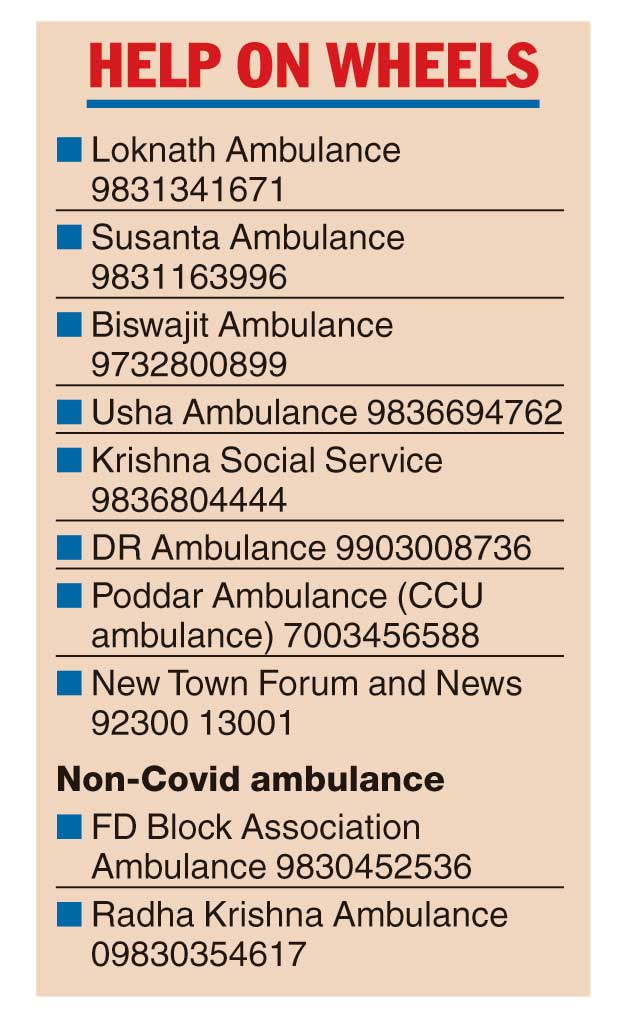
No vaccines for drivers
Those in the business feel they do not receive the respect they should. “Patients misbehave with us, thinking we are in connivance with corporate hospitals, out to fleece them. No one considers us health workers. We are ‘ambulancewallas’ who got into this trade as we couldn’t finish our education,” sighs Biplab.
This is why, they feel, they have been given neither the Covid vaccine nor health insurance cover from the government. “We are holding and lifting Covid patients all day. We are cleaning their blood, vomit and stool. If we aren’t frontline workers, who are?” Biplab asks. None of his workers have got the jab.
Soumen got his vaccine after trying for a fortnight but other drivers who work with him are still trying. “So now besides working round the clock, we are having to queue up from 5am. Not only is it exhausting for us, but we also waste patients’ time like this.” Is anyone listening?

